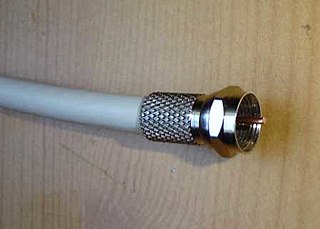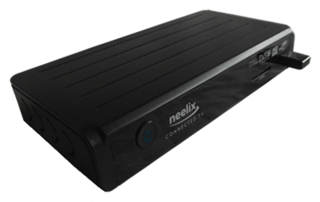
Cable television is a system of delivering television programming to consumers via radio frequency (RF) signals transmitted through coaxial cables, or in more recent systems, light pulses through fibre-optic cables. This contrasts with broadcast television, in which the television signal is transmitted over-the-air by radio waves and received by a television antenna attached to the television; or satellite television, in which the television signal is transmitted over-the-air by radio waves from a communications satellite orbiting the Earth, and received by a satellite dish antenna on the roof. FM radio programming, high-speed Internet, telephone services, and similar non-television services may also be provided through these cables. Analog television was standard in the 20th century, but since the 2000s, cable systems have been upgraded to digital cable operation.

Integrated Services Digital Network (ISDN) is a set of communication standards for simultaneous digital transmission of voice, video, data, and other network services over the digitalised circuits of the public switched telephone network. Work on the standard began in 1980 at Bell Labs and was formally standardized in 1988 in the CCITT "Red Book". By the time the standard was released, newer networking systems with much greater speeds were available, and ISDN saw relatively little uptake in the wider market. One estimate suggests ISDN use peaked at a worldwide total of 25 million subscribers at a time when 1.3 billion analog lines were in use. ISDN has largely been replaced with digital subscriber line (DSL) systems of much higher performance.

A set-top box (STB), also known as a cable box or receiver and historically television decoder or a converter, is an information appliance device that generally contains a TV-tuner input and displays output to a television set and an external source of signal, turning the source signal into content in a form that can then be displayed on the television screen or other display device. They are used in cable television, satellite television, and over-the-air television systems as well as other uses.
Digital subscriber line is a family of technologies that are used to transmit digital data over telephone lines. In telecommunications marketing, the term DSL is widely understood to mean asymmetric digital subscriber line (ADSL), the most commonly installed DSL technology, for Internet access.
Digital cable is the distribution of cable television using digital data and video compression. The technology was first developed by General Instrument. By 2000, most cable companies offered digital features, eventually replacing their previous analog-based cable by the mid 2010s. During the late 2000s, broadcast television converted to the digital HDTV standard, which was incompatible with existing analog cable systems.

Internet Protocol television (IPTV) is the delivery of television content over Internet Protocol (IP) networks. This is in contrast to delivery through traditional terrestrial, satellite, and cable television formats. Unlike downloaded media, IPTV offers the ability to stream the source media continuously. As a result, a client media player can begin playing the content almost immediately. This is known as streaming media.
The Freebox is an ADSL-VDSL-FTTH modem and a set-top box that the French Internet service provider named Free provides to its DSL-FTTH subscribers.

In the field of telecommunications, the concept of triple play service refers to the provision of three essential services — high-speed broadband Internet access, television, and latency-sensitive telephone services — all delivered over a single broadband connection. This approach emphasizes the convergence of multiple services by a single supplier, aiming to enhance user convenience and streamline service delivery.
Sky+ HD was the brand name of the HDTV service launched by Sky plc on 22 May 2006 in the United Kingdom and Ireland to enable high definition channels on Sky to be viewed. For the first two years after launch, the service was branded Sky HD. The service requires the user to have a Sky+ HD Digibox and an HD ready TV. A subscription to the original HD pack carries an extra fee of £10.25 a month in addition to the standard Sky subscription, allowing customers to view HD channels corresponding to the channel packs subscribed to. Additional Pay-Per-View events on Sky Box Office HD are not available to customers unless they subscribe to the Sky HD pack.
TTNET A.Ş., operating under the Türk Telekom brand, is the largest Internet service provider in Turkey and has around 7 million subscribers. TTNET is a subsidiary of Türk Telekom Group.
TalkTalk TV is a UK-based consumer television and video on demand service, operated by the TalkTalk Group. It originally launched in 2000. In September 2012, the current TalkTalk TV was launched in partnership with YouView. Its television and video on demand service is delivered over a BT phone line, using ADSL or VDSL. It provides IPTV, video on demand, telephony and broadband internet access.
Multichannel television in the United States has been available since at least 1948. The United States is served by multichannel television through cable television systems, direct-broadcast satellite providers, and various other wireline video providers; among the largest television providers in the U.S. are YouTube TV, DirecTV, Altice USA, Charter Communications, Comcast, Dish Network, Verizon Communications, and Cox Communications. The Telecommunications Act of 1996 defines a multichannel video programming distributor (MVPD) as "a person such as, but not limited to, a cable operator, a multichannel multipoint distribution service, a direct broadcast satellite service, or a television receive-only satellite program distributor, who makes available for purchase, by subscribers or customers, multiple channels of video programming", where a channel is defined as a "signaling path provided by a cable television system."

Bell Fibe TV is an IP-based television service offered by Bell Canada in the provinces of Ontario and Quebec. It is bundled with a FTTN or FTTH Bell Internet service, and uses the Mediaroom platform. Bell Fibe TV officially launched on September 13, 2010. It is also available in Manitoba and Atlantic Canada, where Fibe TV is re-packaged, being offered by Bell MTS and Bell Aliant with similar services and integrated with Bell Fibe TV.

Fetch TV is an Australian IPTV provider that offers a subscription television service over a user's regular internet connection. It is majority owned by Telstra, who acquired a 51.4% stake in the company on the 2nd of August 2022. Fetch TV was initially launched in July 2010 by Malaysian Astro Malaysia Holdings.

GlobeCast World TV was a television via satellite service received in North America via the Galaxy 19 satellite, providing ethnic television and audio channels. It was a service by Globecast, a subsidiary of Orange. In North America, the satellite broadcasts dozens of Arabic and Asian channels.

Unifi TV is an IPTV service operated by unifi. It was launched in 2010 as part of Unifi's bundled Triple-play service offering of VoIP Telephone, Internet and IPTV called Unifi TV.

Ziggo Holding B.V. is the largest cable operator in the Netherlands, providing digital cable television, Internet, and telephone service to both residential and commercial customers.
Distributel is a brand of Bell Canada headquartered in Toronto, Ontario, founded in 1988 and offering Canadians long distance phone service. Distributel now offers a wide range of high speed Internet plans in Ontario, Quebec, British Columbia and Alberta as well as VoIP Digital Home Phone service across Canada. Distributel also provides IPTV in all major markets in Ontario and Quebec.

TOYA is a Polish cable and digital television and telecommunications provider with headquarters in Łódź. The company's network covers eight cities – Łódź, Kraków, Mysłowice, Kutno, Przemyśl, Piotrków Trybunalski, Pisz and Pabianice. TOYA products and services are available in thirteen partner networks of other operators across 25 locations.
Optimum is an American telecommunications brand owned and operated by Altice USA. It is the fourth largest cable provider in the United States and a Fortune 500 company. Optimum offers Internet, television, mobile and home phone serving in Arizona, Arkansas, California, Connecticut, Idaho, Kentucky, Louisiana, Mississippi, Missouri, New Jersey, Long Island and New York, North Carolina, Ohio, Oklahoma, Pennsylvania, Texas, and West Virginia.












